HRM Case Study: Challenges in a Global Economy - Analysis
VerifiedAdded on 2023/01/13
|13
|3619
|34
Report
AI Summary
This report examines a case study of 'No Name' Aircraft, focusing on human resource management (HRM) challenges in a global economy. The analysis covers issues in training and development, organizational culture, diversity management, and performance management across its operations in Vietnam, China, and Singapore. The report highlights the importance of effective training to improve service quality, minimize costs, and foster employee motivation. It explores the significance of performance management, including feedback mechanisms and communication strategies. The case study also addresses diversity management, emphasizing the need for equal opportunities and adherence to cultural and legal considerations. Furthermore, the report delves into the types and theories of diversity management, organizational culture, international performance management, and training and development, along with the associated theories, to provide a comprehensive understanding of the issues and potential solutions within the context of a globalized business environment.
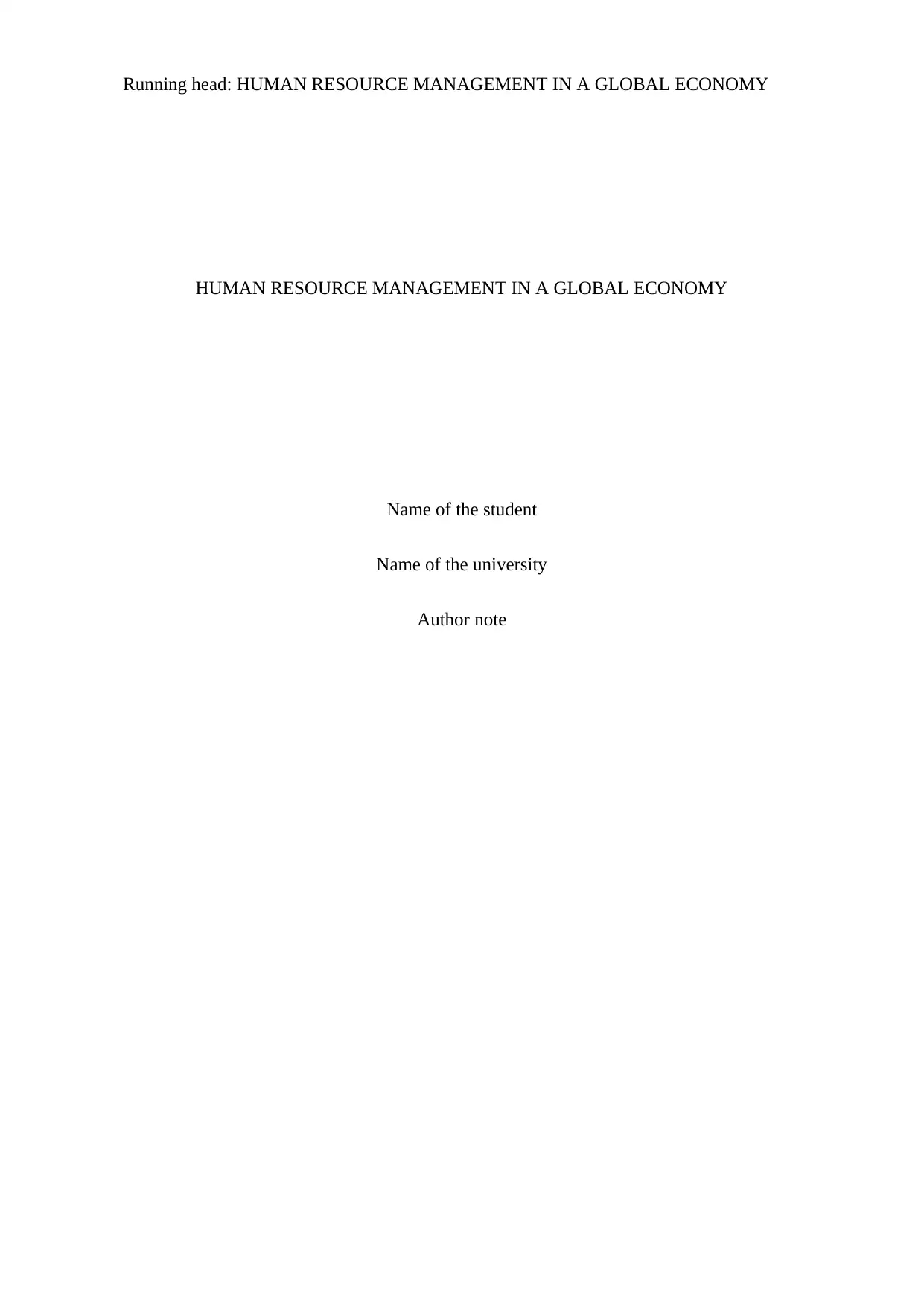
Running head: HUMAN RESOURCE MANAGEMENT IN A GLOBAL ECONOMY
HUMAN RESOURCE MANAGEMENT IN A GLOBAL ECONOMY
Name of the student
Name of the university
Author note
HUMAN RESOURCE MANAGEMENT IN A GLOBAL ECONOMY
Name of the student
Name of the university
Author note
Paraphrase This Document
Need a fresh take? Get an instant paraphrase of this document with our AI Paraphraser
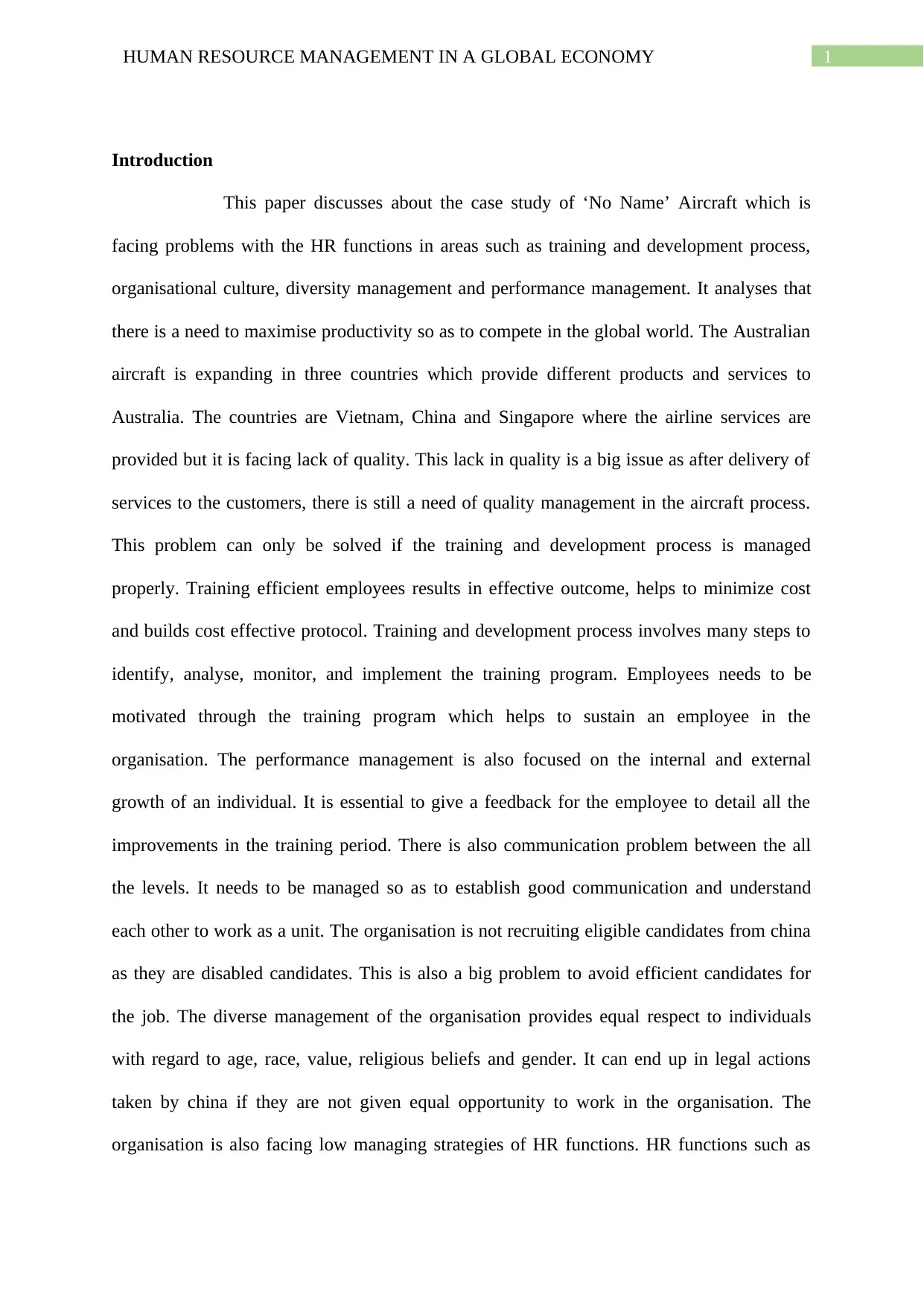
1HUMAN RESOURCE MANAGEMENT IN A GLOBAL ECONOMY
Introduction
This paper discusses about the case study of ‘No Name’ Aircraft which is
facing problems with the HR functions in areas such as training and development process,
organisational culture, diversity management and performance management. It analyses that
there is a need to maximise productivity so as to compete in the global world. The Australian
aircraft is expanding in three countries which provide different products and services to
Australia. The countries are Vietnam, China and Singapore where the airline services are
provided but it is facing lack of quality. This lack in quality is a big issue as after delivery of
services to the customers, there is still a need of quality management in the aircraft process.
This problem can only be solved if the training and development process is managed
properly. Training efficient employees results in effective outcome, helps to minimize cost
and builds cost effective protocol. Training and development process involves many steps to
identify, analyse, monitor, and implement the training program. Employees needs to be
motivated through the training program which helps to sustain an employee in the
organisation. The performance management is also focused on the internal and external
growth of an individual. It is essential to give a feedback for the employee to detail all the
improvements in the training period. There is also communication problem between the all
the levels. It needs to be managed so as to establish good communication and understand
each other to work as a unit. The organisation is not recruiting eligible candidates from china
as they are disabled candidates. This is also a big problem to avoid efficient candidates for
the job. The diverse management of the organisation provides equal respect to individuals
with regard to age, race, value, religious beliefs and gender. It can end up in legal actions
taken by china if they are not given equal opportunity to work in the organisation. The
organisation is also facing low managing strategies of HR functions. HR functions such as
Introduction
This paper discusses about the case study of ‘No Name’ Aircraft which is
facing problems with the HR functions in areas such as training and development process,
organisational culture, diversity management and performance management. It analyses that
there is a need to maximise productivity so as to compete in the global world. The Australian
aircraft is expanding in three countries which provide different products and services to
Australia. The countries are Vietnam, China and Singapore where the airline services are
provided but it is facing lack of quality. This lack in quality is a big issue as after delivery of
services to the customers, there is still a need of quality management in the aircraft process.
This problem can only be solved if the training and development process is managed
properly. Training efficient employees results in effective outcome, helps to minimize cost
and builds cost effective protocol. Training and development process involves many steps to
identify, analyse, monitor, and implement the training program. Employees needs to be
motivated through the training program which helps to sustain an employee in the
organisation. The performance management is also focused on the internal and external
growth of an individual. It is essential to give a feedback for the employee to detail all the
improvements in the training period. There is also communication problem between the all
the levels. It needs to be managed so as to establish good communication and understand
each other to work as a unit. The organisation is not recruiting eligible candidates from china
as they are disabled candidates. This is also a big problem to avoid efficient candidates for
the job. The diverse management of the organisation provides equal respect to individuals
with regard to age, race, value, religious beliefs and gender. It can end up in legal actions
taken by china if they are not given equal opportunity to work in the organisation. The
organisation is also facing low managing strategies of HR functions. HR functions such as
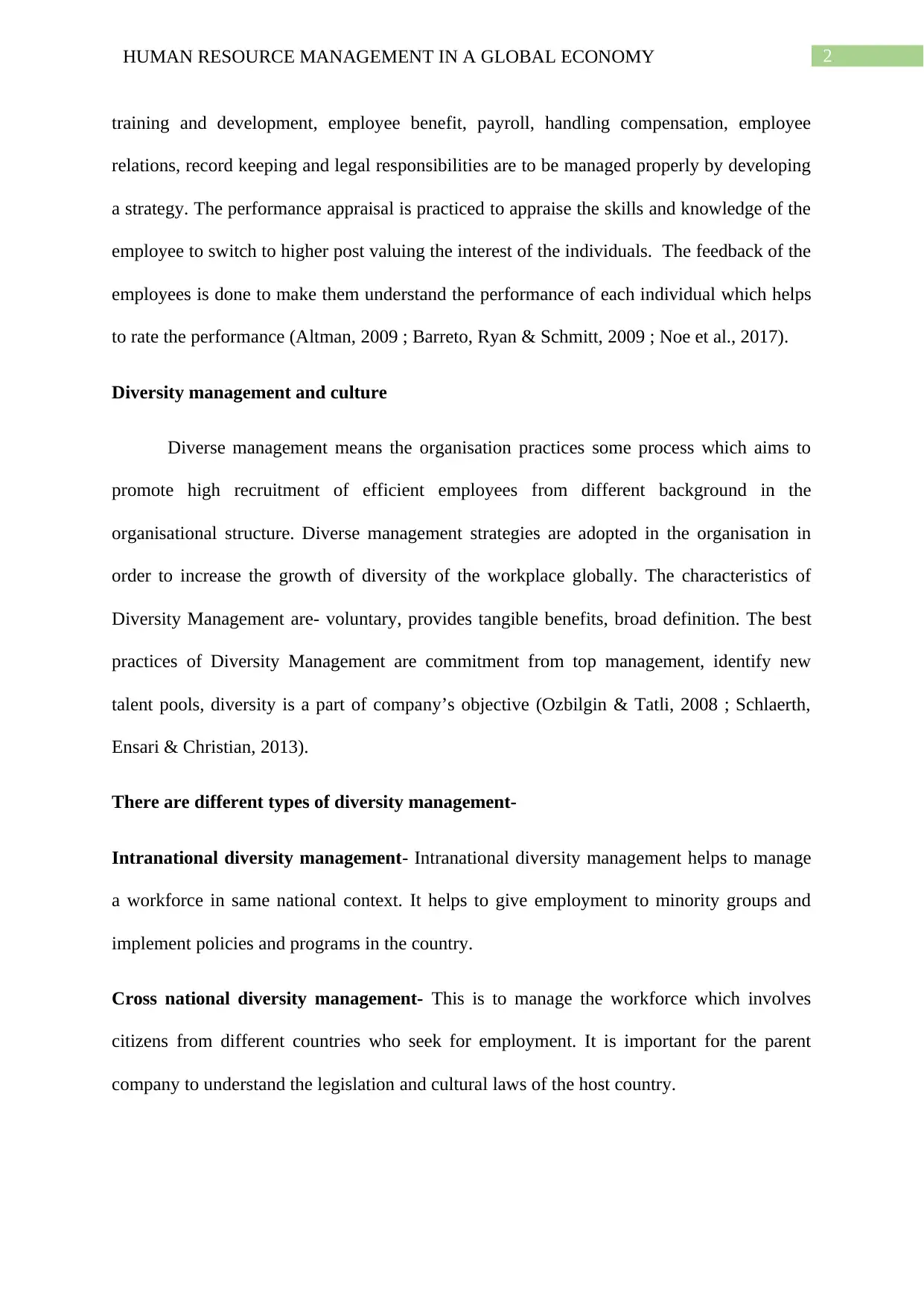
2HUMAN RESOURCE MANAGEMENT IN A GLOBAL ECONOMY
training and development, employee benefit, payroll, handling compensation, employee
relations, record keeping and legal responsibilities are to be managed properly by developing
a strategy. The performance appraisal is practiced to appraise the skills and knowledge of the
employee to switch to higher post valuing the interest of the individuals. The feedback of the
employees is done to make them understand the performance of each individual which helps
to rate the performance (Altman, 2009 ; Barreto, Ryan & Schmitt, 2009 ; Noe et al., 2017).
Diversity management and culture
Diverse management means the organisation practices some process which aims to
promote high recruitment of efficient employees from different background in the
organisational structure. Diverse management strategies are adopted in the organisation in
order to increase the growth of diversity of the workplace globally. The characteristics of
Diversity Management are- voluntary, provides tangible benefits, broad definition. The best
practices of Diversity Management are commitment from top management, identify new
talent pools, diversity is a part of company’s objective (Ozbilgin & Tatli, 2008 ; Schlaerth,
Ensari & Christian, 2013).
There are different types of diversity management-
Intranational diversity management- Intranational diversity management helps to manage
a workforce in same national context. It helps to give employment to minority groups and
implement policies and programs in the country.
Cross national diversity management- This is to manage the workforce which involves
citizens from different countries who seek for employment. It is important for the parent
company to understand the legislation and cultural laws of the host country.
training and development, employee benefit, payroll, handling compensation, employee
relations, record keeping and legal responsibilities are to be managed properly by developing
a strategy. The performance appraisal is practiced to appraise the skills and knowledge of the
employee to switch to higher post valuing the interest of the individuals. The feedback of the
employees is done to make them understand the performance of each individual which helps
to rate the performance (Altman, 2009 ; Barreto, Ryan & Schmitt, 2009 ; Noe et al., 2017).
Diversity management and culture
Diverse management means the organisation practices some process which aims to
promote high recruitment of efficient employees from different background in the
organisational structure. Diverse management strategies are adopted in the organisation in
order to increase the growth of diversity of the workplace globally. The characteristics of
Diversity Management are- voluntary, provides tangible benefits, broad definition. The best
practices of Diversity Management are commitment from top management, identify new
talent pools, diversity is a part of company’s objective (Ozbilgin & Tatli, 2008 ; Schlaerth,
Ensari & Christian, 2013).
There are different types of diversity management-
Intranational diversity management- Intranational diversity management helps to manage
a workforce in same national context. It helps to give employment to minority groups and
implement policies and programs in the country.
Cross national diversity management- This is to manage the workforce which involves
citizens from different countries who seek for employment. It is important for the parent
company to understand the legislation and cultural laws of the host country.
⊘ This is a preview!⊘
Do you want full access?
Subscribe today to unlock all pages.

Trusted by 1+ million students worldwide
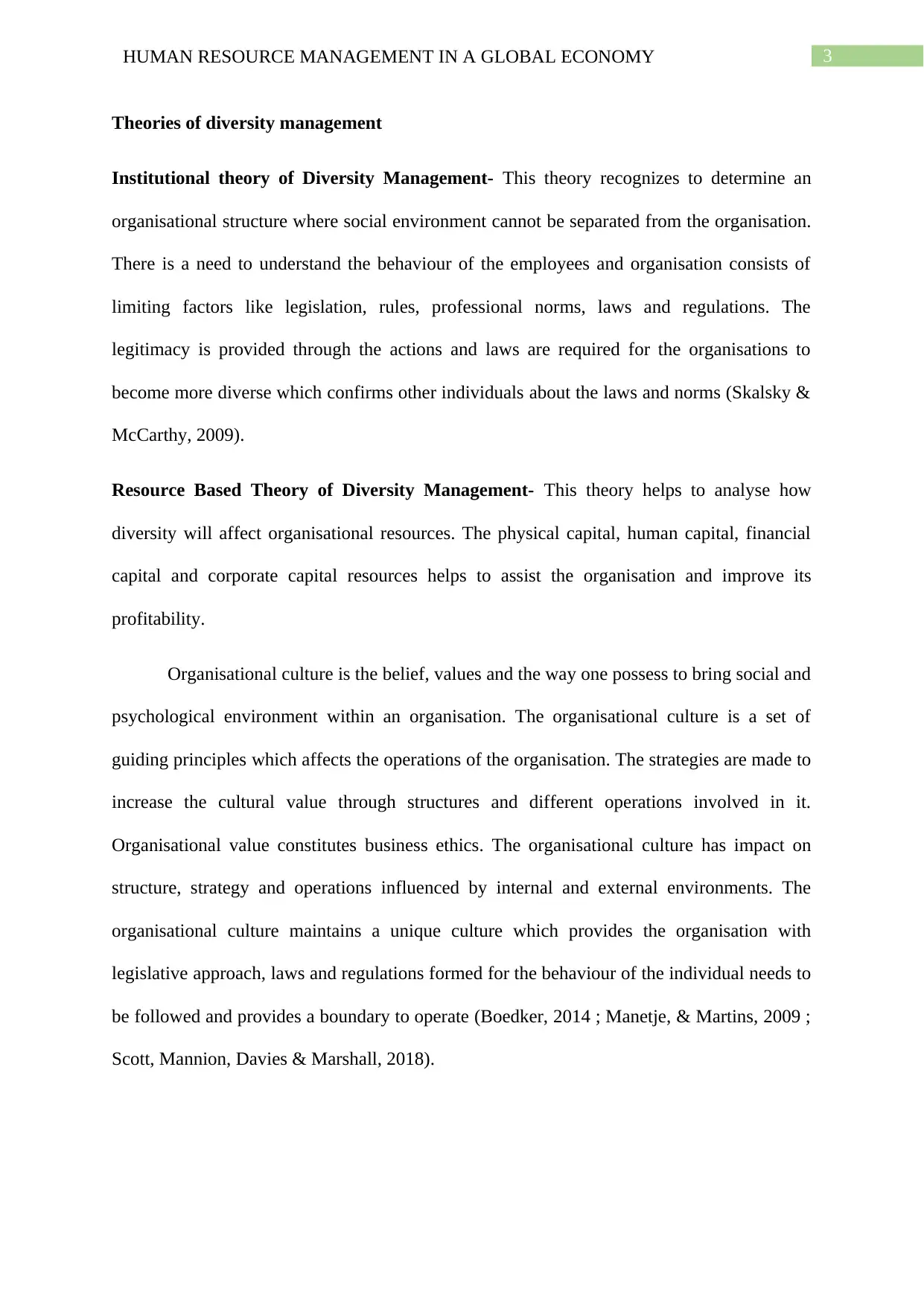
3HUMAN RESOURCE MANAGEMENT IN A GLOBAL ECONOMY
Theories of diversity management
Institutional theory of Diversity Management- This theory recognizes to determine an
organisational structure where social environment cannot be separated from the organisation.
There is a need to understand the behaviour of the employees and organisation consists of
limiting factors like legislation, rules, professional norms, laws and regulations. The
legitimacy is provided through the actions and laws are required for the organisations to
become more diverse which confirms other individuals about the laws and norms (Skalsky &
McCarthy, 2009).
Resource Based Theory of Diversity Management- This theory helps to analyse how
diversity will affect organisational resources. The physical capital, human capital, financial
capital and corporate capital resources helps to assist the organisation and improve its
profitability.
Organisational culture is the belief, values and the way one possess to bring social and
psychological environment within an organisation. The organisational culture is a set of
guiding principles which affects the operations of the organisation. The strategies are made to
increase the cultural value through structures and different operations involved in it.
Organisational value constitutes business ethics. The organisational culture has impact on
structure, strategy and operations influenced by internal and external environments. The
organisational culture maintains a unique culture which provides the organisation with
legislative approach, laws and regulations formed for the behaviour of the individual needs to
be followed and provides a boundary to operate (Boedker, 2014 ; Manetje, & Martins, 2009 ;
Scott, Mannion, Davies & Marshall, 2018).
Theories of diversity management
Institutional theory of Diversity Management- This theory recognizes to determine an
organisational structure where social environment cannot be separated from the organisation.
There is a need to understand the behaviour of the employees and organisation consists of
limiting factors like legislation, rules, professional norms, laws and regulations. The
legitimacy is provided through the actions and laws are required for the organisations to
become more diverse which confirms other individuals about the laws and norms (Skalsky &
McCarthy, 2009).
Resource Based Theory of Diversity Management- This theory helps to analyse how
diversity will affect organisational resources. The physical capital, human capital, financial
capital and corporate capital resources helps to assist the organisation and improve its
profitability.
Organisational culture is the belief, values and the way one possess to bring social and
psychological environment within an organisation. The organisational culture is a set of
guiding principles which affects the operations of the organisation. The strategies are made to
increase the cultural value through structures and different operations involved in it.
Organisational value constitutes business ethics. The organisational culture has impact on
structure, strategy and operations influenced by internal and external environments. The
organisational culture maintains a unique culture which provides the organisation with
legislative approach, laws and regulations formed for the behaviour of the individual needs to
be followed and provides a boundary to operate (Boedker, 2014 ; Manetje, & Martins, 2009 ;
Scott, Mannion, Davies & Marshall, 2018).
Paraphrase This Document
Need a fresh take? Get an instant paraphrase of this document with our AI Paraphraser
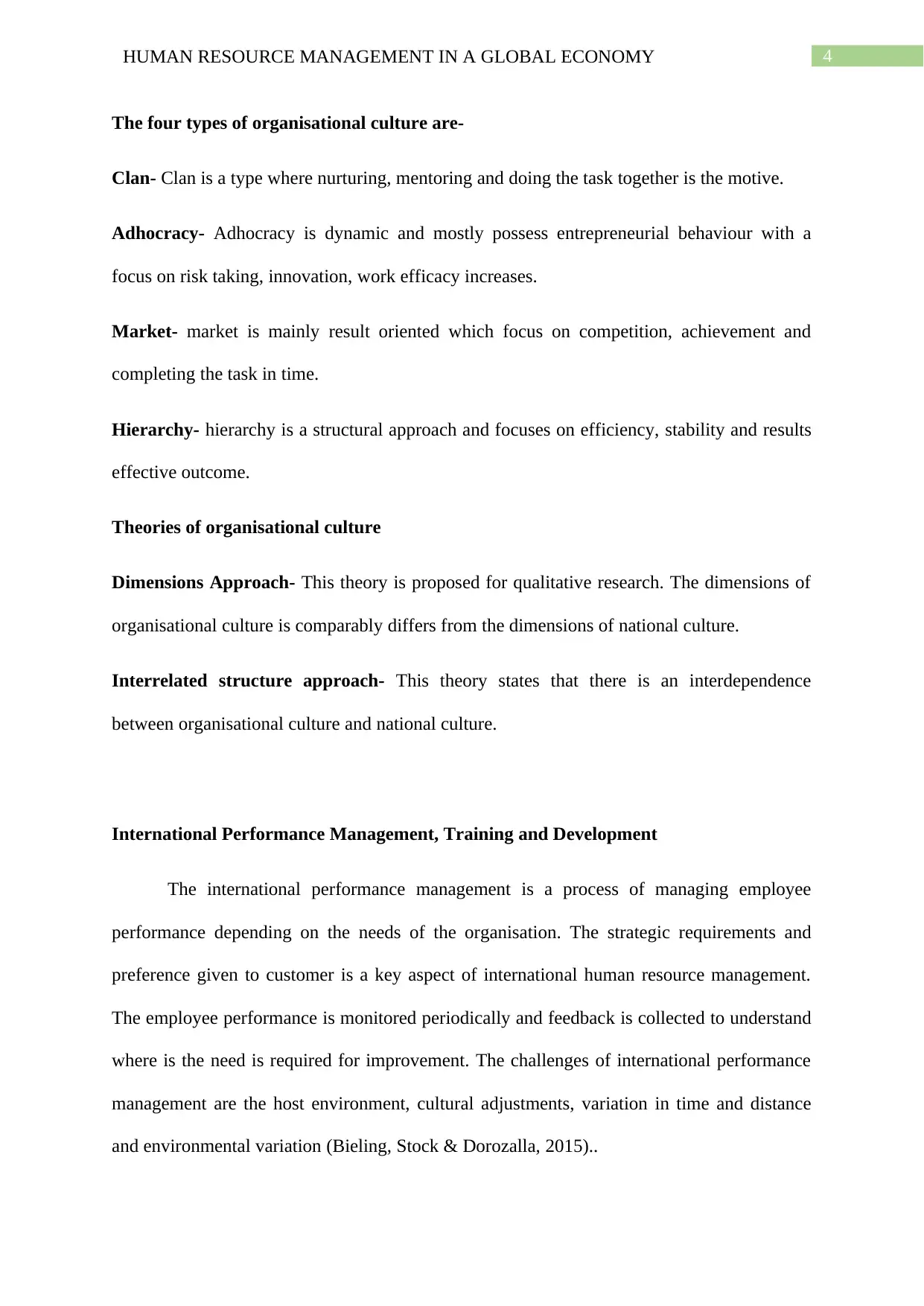
4HUMAN RESOURCE MANAGEMENT IN A GLOBAL ECONOMY
The four types of organisational culture are-
Clan- Clan is a type where nurturing, mentoring and doing the task together is the motive.
Adhocracy- Adhocracy is dynamic and mostly possess entrepreneurial behaviour with a
focus on risk taking, innovation, work efficacy increases.
Market- market is mainly result oriented which focus on competition, achievement and
completing the task in time.
Hierarchy- hierarchy is a structural approach and focuses on efficiency, stability and results
effective outcome.
Theories of organisational culture
Dimensions Approach- This theory is proposed for qualitative research. The dimensions of
organisational culture is comparably differs from the dimensions of national culture.
Interrelated structure approach- This theory states that there is an interdependence
between organisational culture and national culture.
International Performance Management, Training and Development
The international performance management is a process of managing employee
performance depending on the needs of the organisation. The strategic requirements and
preference given to customer is a key aspect of international human resource management.
The employee performance is monitored periodically and feedback is collected to understand
where is the need is required for improvement. The challenges of international performance
management are the host environment, cultural adjustments, variation in time and distance
and environmental variation (Bieling, Stock & Dorozalla, 2015)..
The four types of organisational culture are-
Clan- Clan is a type where nurturing, mentoring and doing the task together is the motive.
Adhocracy- Adhocracy is dynamic and mostly possess entrepreneurial behaviour with a
focus on risk taking, innovation, work efficacy increases.
Market- market is mainly result oriented which focus on competition, achievement and
completing the task in time.
Hierarchy- hierarchy is a structural approach and focuses on efficiency, stability and results
effective outcome.
Theories of organisational culture
Dimensions Approach- This theory is proposed for qualitative research. The dimensions of
organisational culture is comparably differs from the dimensions of national culture.
Interrelated structure approach- This theory states that there is an interdependence
between organisational culture and national culture.
International Performance Management, Training and Development
The international performance management is a process of managing employee
performance depending on the needs of the organisation. The strategic requirements and
preference given to customer is a key aspect of international human resource management.
The employee performance is monitored periodically and feedback is collected to understand
where is the need is required for improvement. The challenges of international performance
management are the host environment, cultural adjustments, variation in time and distance
and environmental variation (Bieling, Stock & Dorozalla, 2015)..
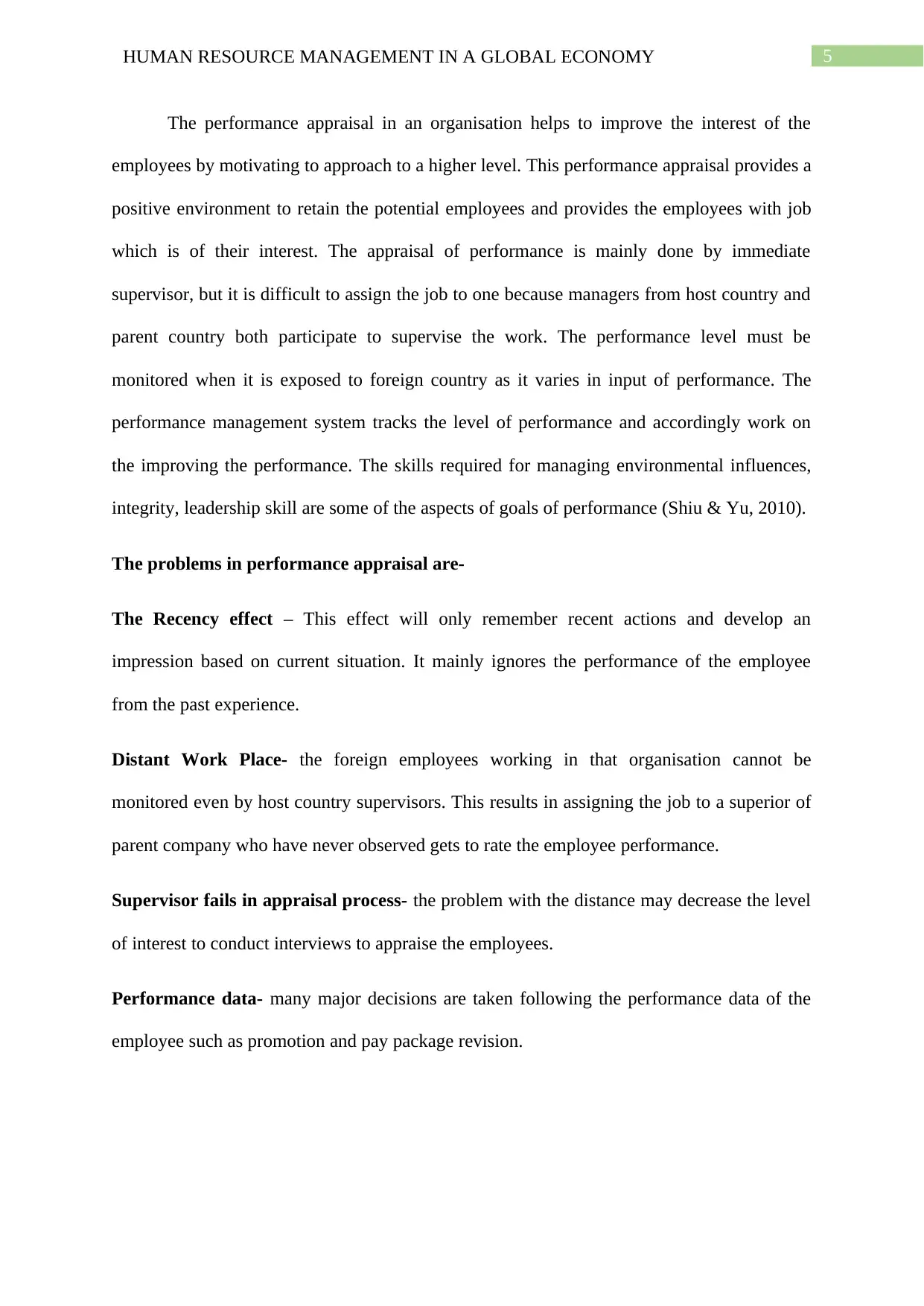
5HUMAN RESOURCE MANAGEMENT IN A GLOBAL ECONOMY
The performance appraisal in an organisation helps to improve the interest of the
employees by motivating to approach to a higher level. This performance appraisal provides a
positive environment to retain the potential employees and provides the employees with job
which is of their interest. The appraisal of performance is mainly done by immediate
supervisor, but it is difficult to assign the job to one because managers from host country and
parent country both participate to supervise the work. The performance level must be
monitored when it is exposed to foreign country as it varies in input of performance. The
performance management system tracks the level of performance and accordingly work on
the improving the performance. The skills required for managing environmental influences,
integrity, leadership skill are some of the aspects of goals of performance (Shiu & Yu, 2010).
The problems in performance appraisal are-
The Recency effect – This effect will only remember recent actions and develop an
impression based on current situation. It mainly ignores the performance of the employee
from the past experience.
Distant Work Place- the foreign employees working in that organisation cannot be
monitored even by host country supervisors. This results in assigning the job to a superior of
parent company who have never observed gets to rate the employee performance.
Supervisor fails in appraisal process- the problem with the distance may decrease the level
of interest to conduct interviews to appraise the employees.
Performance data- many major decisions are taken following the performance data of the
employee such as promotion and pay package revision.
The performance appraisal in an organisation helps to improve the interest of the
employees by motivating to approach to a higher level. This performance appraisal provides a
positive environment to retain the potential employees and provides the employees with job
which is of their interest. The appraisal of performance is mainly done by immediate
supervisor, but it is difficult to assign the job to one because managers from host country and
parent country both participate to supervise the work. The performance level must be
monitored when it is exposed to foreign country as it varies in input of performance. The
performance management system tracks the level of performance and accordingly work on
the improving the performance. The skills required for managing environmental influences,
integrity, leadership skill are some of the aspects of goals of performance (Shiu & Yu, 2010).
The problems in performance appraisal are-
The Recency effect – This effect will only remember recent actions and develop an
impression based on current situation. It mainly ignores the performance of the employee
from the past experience.
Distant Work Place- the foreign employees working in that organisation cannot be
monitored even by host country supervisors. This results in assigning the job to a superior of
parent company who have never observed gets to rate the employee performance.
Supervisor fails in appraisal process- the problem with the distance may decrease the level
of interest to conduct interviews to appraise the employees.
Performance data- many major decisions are taken following the performance data of the
employee such as promotion and pay package revision.
⊘ This is a preview!⊘
Do you want full access?
Subscribe today to unlock all pages.

Trusted by 1+ million students worldwide
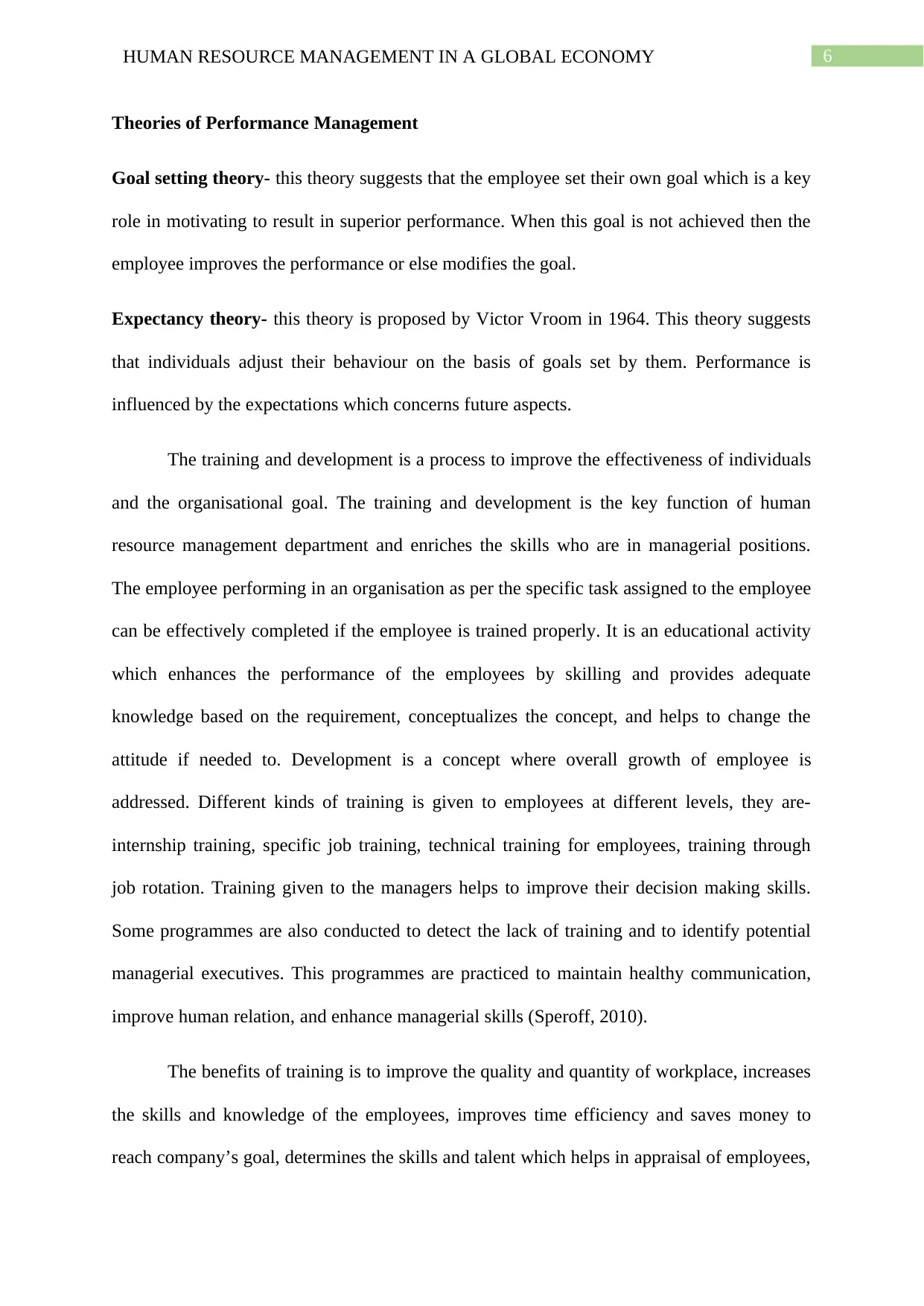
6HUMAN RESOURCE MANAGEMENT IN A GLOBAL ECONOMY
Theories of Performance Management
Goal setting theory- this theory suggests that the employee set their own goal which is a key
role in motivating to result in superior performance. When this goal is not achieved then the
employee improves the performance or else modifies the goal.
Expectancy theory- this theory is proposed by Victor Vroom in 1964. This theory suggests
that individuals adjust their behaviour on the basis of goals set by them. Performance is
influenced by the expectations which concerns future aspects.
The training and development is a process to improve the effectiveness of individuals
and the organisational goal. The training and development is the key function of human
resource management department and enriches the skills who are in managerial positions.
The employee performing in an organisation as per the specific task assigned to the employee
can be effectively completed if the employee is trained properly. It is an educational activity
which enhances the performance of the employees by skilling and provides adequate
knowledge based on the requirement, conceptualizes the concept, and helps to change the
attitude if needed to. Development is a concept where overall growth of employee is
addressed. Different kinds of training is given to employees at different levels, they are-
internship training, specific job training, technical training for employees, training through
job rotation. Training given to the managers helps to improve their decision making skills.
Some programmes are also conducted to detect the lack of training and to identify potential
managerial executives. This programmes are practiced to maintain healthy communication,
improve human relation, and enhance managerial skills (Speroff, 2010).
The benefits of training is to improve the quality and quantity of workplace, increases
the skills and knowledge of the employees, improves time efficiency and saves money to
reach company’s goal, determines the skills and talent which helps in appraisal of employees,
Theories of Performance Management
Goal setting theory- this theory suggests that the employee set their own goal which is a key
role in motivating to result in superior performance. When this goal is not achieved then the
employee improves the performance or else modifies the goal.
Expectancy theory- this theory is proposed by Victor Vroom in 1964. This theory suggests
that individuals adjust their behaviour on the basis of goals set by them. Performance is
influenced by the expectations which concerns future aspects.
The training and development is a process to improve the effectiveness of individuals
and the organisational goal. The training and development is the key function of human
resource management department and enriches the skills who are in managerial positions.
The employee performing in an organisation as per the specific task assigned to the employee
can be effectively completed if the employee is trained properly. It is an educational activity
which enhances the performance of the employees by skilling and provides adequate
knowledge based on the requirement, conceptualizes the concept, and helps to change the
attitude if needed to. Development is a concept where overall growth of employee is
addressed. Different kinds of training is given to employees at different levels, they are-
internship training, specific job training, technical training for employees, training through
job rotation. Training given to the managers helps to improve their decision making skills.
Some programmes are also conducted to detect the lack of training and to identify potential
managerial executives. This programmes are practiced to maintain healthy communication,
improve human relation, and enhance managerial skills (Speroff, 2010).
The benefits of training is to improve the quality and quantity of workplace, increases
the skills and knowledge of the employees, improves time efficiency and saves money to
reach company’s goal, determines the skills and talent which helps in appraisal of employees,
Paraphrase This Document
Need a fresh take? Get an instant paraphrase of this document with our AI Paraphraser
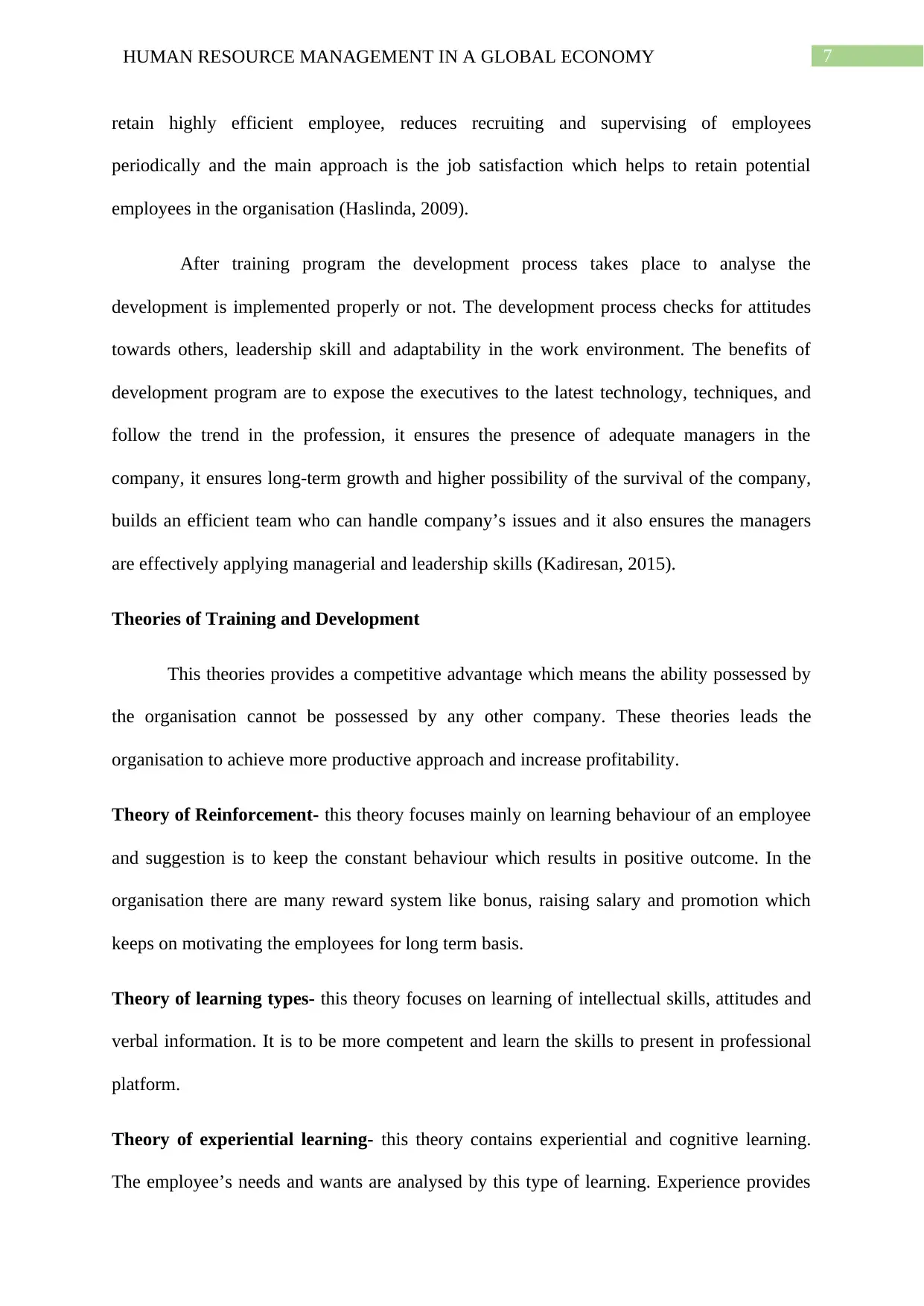
7HUMAN RESOURCE MANAGEMENT IN A GLOBAL ECONOMY
retain highly efficient employee, reduces recruiting and supervising of employees
periodically and the main approach is the job satisfaction which helps to retain potential
employees in the organisation (Haslinda, 2009).
After training program the development process takes place to analyse the
development is implemented properly or not. The development process checks for attitudes
towards others, leadership skill and adaptability in the work environment. The benefits of
development program are to expose the executives to the latest technology, techniques, and
follow the trend in the profession, it ensures the presence of adequate managers in the
company, it ensures long-term growth and higher possibility of the survival of the company,
builds an efficient team who can handle company’s issues and it also ensures the managers
are effectively applying managerial and leadership skills (Kadiresan, 2015).
Theories of Training and Development
This theories provides a competitive advantage which means the ability possessed by
the organisation cannot be possessed by any other company. These theories leads the
organisation to achieve more productive approach and increase profitability.
Theory of Reinforcement- this theory focuses mainly on learning behaviour of an employee
and suggestion is to keep the constant behaviour which results in positive outcome. In the
organisation there are many reward system like bonus, raising salary and promotion which
keeps on motivating the employees for long term basis.
Theory of learning types- this theory focuses on learning of intellectual skills, attitudes and
verbal information. It is to be more competent and learn the skills to present in professional
platform.
Theory of experiential learning- this theory contains experiential and cognitive learning.
The employee’s needs and wants are analysed by this type of learning. Experience provides
retain highly efficient employee, reduces recruiting and supervising of employees
periodically and the main approach is the job satisfaction which helps to retain potential
employees in the organisation (Haslinda, 2009).
After training program the development process takes place to analyse the
development is implemented properly or not. The development process checks for attitudes
towards others, leadership skill and adaptability in the work environment. The benefits of
development program are to expose the executives to the latest technology, techniques, and
follow the trend in the profession, it ensures the presence of adequate managers in the
company, it ensures long-term growth and higher possibility of the survival of the company,
builds an efficient team who can handle company’s issues and it also ensures the managers
are effectively applying managerial and leadership skills (Kadiresan, 2015).
Theories of Training and Development
This theories provides a competitive advantage which means the ability possessed by
the organisation cannot be possessed by any other company. These theories leads the
organisation to achieve more productive approach and increase profitability.
Theory of Reinforcement- this theory focuses mainly on learning behaviour of an employee
and suggestion is to keep the constant behaviour which results in positive outcome. In the
organisation there are many reward system like bonus, raising salary and promotion which
keeps on motivating the employees for long term basis.
Theory of learning types- this theory focuses on learning of intellectual skills, attitudes and
verbal information. It is to be more competent and learn the skills to present in professional
platform.
Theory of experiential learning- this theory contains experiential and cognitive learning.
The employee’s needs and wants are analysed by this type of learning. Experience provides
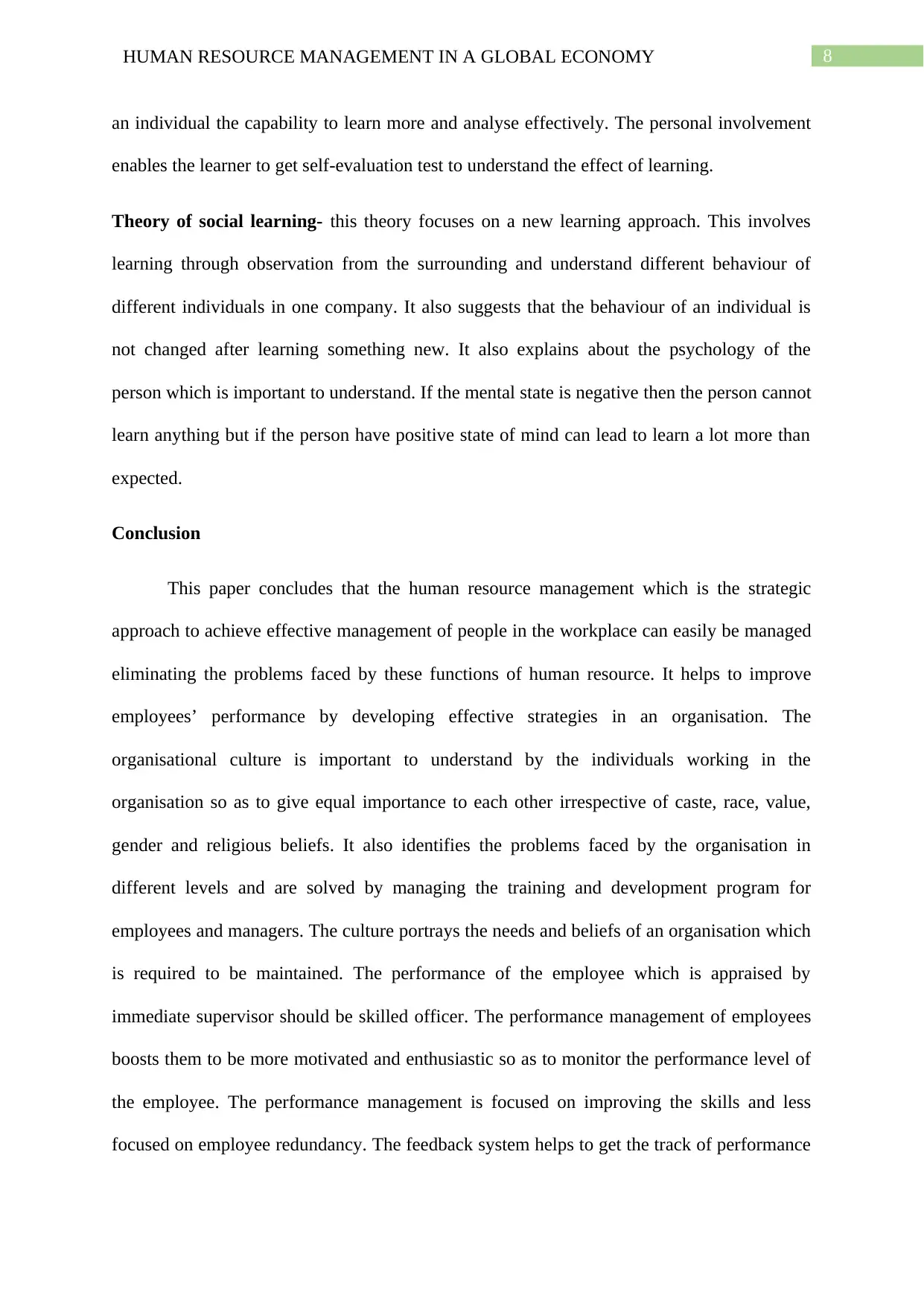
8HUMAN RESOURCE MANAGEMENT IN A GLOBAL ECONOMY
an individual the capability to learn more and analyse effectively. The personal involvement
enables the learner to get self-evaluation test to understand the effect of learning.
Theory of social learning- this theory focuses on a new learning approach. This involves
learning through observation from the surrounding and understand different behaviour of
different individuals in one company. It also suggests that the behaviour of an individual is
not changed after learning something new. It also explains about the psychology of the
person which is important to understand. If the mental state is negative then the person cannot
learn anything but if the person have positive state of mind can lead to learn a lot more than
expected.
Conclusion
This paper concludes that the human resource management which is the strategic
approach to achieve effective management of people in the workplace can easily be managed
eliminating the problems faced by these functions of human resource. It helps to improve
employees’ performance by developing effective strategies in an organisation. The
organisational culture is important to understand by the individuals working in the
organisation so as to give equal importance to each other irrespective of caste, race, value,
gender and religious beliefs. It also identifies the problems faced by the organisation in
different levels and are solved by managing the training and development program for
employees and managers. The culture portrays the needs and beliefs of an organisation which
is required to be maintained. The performance of the employee which is appraised by
immediate supervisor should be skilled officer. The performance management of employees
boosts them to be more motivated and enthusiastic so as to monitor the performance level of
the employee. The performance management is focused on improving the skills and less
focused on employee redundancy. The feedback system helps to get the track of performance
an individual the capability to learn more and analyse effectively. The personal involvement
enables the learner to get self-evaluation test to understand the effect of learning.
Theory of social learning- this theory focuses on a new learning approach. This involves
learning through observation from the surrounding and understand different behaviour of
different individuals in one company. It also suggests that the behaviour of an individual is
not changed after learning something new. It also explains about the psychology of the
person which is important to understand. If the mental state is negative then the person cannot
learn anything but if the person have positive state of mind can lead to learn a lot more than
expected.
Conclusion
This paper concludes that the human resource management which is the strategic
approach to achieve effective management of people in the workplace can easily be managed
eliminating the problems faced by these functions of human resource. It helps to improve
employees’ performance by developing effective strategies in an organisation. The
organisational culture is important to understand by the individuals working in the
organisation so as to give equal importance to each other irrespective of caste, race, value,
gender and religious beliefs. It also identifies the problems faced by the organisation in
different levels and are solved by managing the training and development program for
employees and managers. The culture portrays the needs and beliefs of an organisation which
is required to be maintained. The performance of the employee which is appraised by
immediate supervisor should be skilled officer. The performance management of employees
boosts them to be more motivated and enthusiastic so as to monitor the performance level of
the employee. The performance management is focused on improving the skills and less
focused on employee redundancy. The feedback system helps to get the track of performance
⊘ This is a preview!⊘
Do you want full access?
Subscribe today to unlock all pages.

Trusted by 1+ million students worldwide
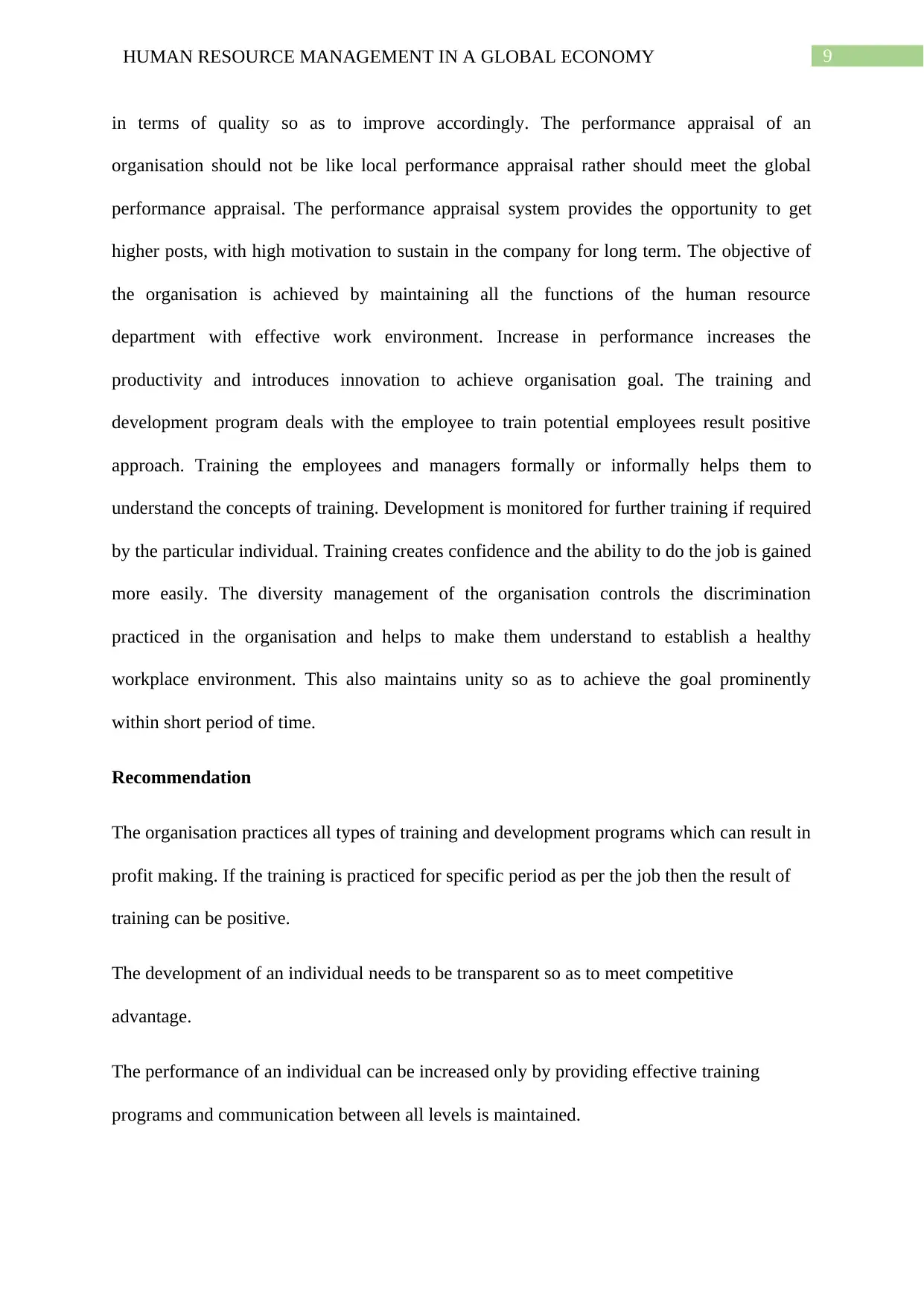
9HUMAN RESOURCE MANAGEMENT IN A GLOBAL ECONOMY
in terms of quality so as to improve accordingly. The performance appraisal of an
organisation should not be like local performance appraisal rather should meet the global
performance appraisal. The performance appraisal system provides the opportunity to get
higher posts, with high motivation to sustain in the company for long term. The objective of
the organisation is achieved by maintaining all the functions of the human resource
department with effective work environment. Increase in performance increases the
productivity and introduces innovation to achieve organisation goal. The training and
development program deals with the employee to train potential employees result positive
approach. Training the employees and managers formally or informally helps them to
understand the concepts of training. Development is monitored for further training if required
by the particular individual. Training creates confidence and the ability to do the job is gained
more easily. The diversity management of the organisation controls the discrimination
practiced in the organisation and helps to make them understand to establish a healthy
workplace environment. This also maintains unity so as to achieve the goal prominently
within short period of time.
Recommendation
The organisation practices all types of training and development programs which can result in
profit making. If the training is practiced for specific period as per the job then the result of
training can be positive.
The development of an individual needs to be transparent so as to meet competitive
advantage.
The performance of an individual can be increased only by providing effective training
programs and communication between all levels is maintained.
in terms of quality so as to improve accordingly. The performance appraisal of an
organisation should not be like local performance appraisal rather should meet the global
performance appraisal. The performance appraisal system provides the opportunity to get
higher posts, with high motivation to sustain in the company for long term. The objective of
the organisation is achieved by maintaining all the functions of the human resource
department with effective work environment. Increase in performance increases the
productivity and introduces innovation to achieve organisation goal. The training and
development program deals with the employee to train potential employees result positive
approach. Training the employees and managers formally or informally helps them to
understand the concepts of training. Development is monitored for further training if required
by the particular individual. Training creates confidence and the ability to do the job is gained
more easily. The diversity management of the organisation controls the discrimination
practiced in the organisation and helps to make them understand to establish a healthy
workplace environment. This also maintains unity so as to achieve the goal prominently
within short period of time.
Recommendation
The organisation practices all types of training and development programs which can result in
profit making. If the training is practiced for specific period as per the job then the result of
training can be positive.
The development of an individual needs to be transparent so as to meet competitive
advantage.
The performance of an individual can be increased only by providing effective training
programs and communication between all levels is maintained.
Paraphrase This Document
Need a fresh take? Get an instant paraphrase of this document with our AI Paraphraser
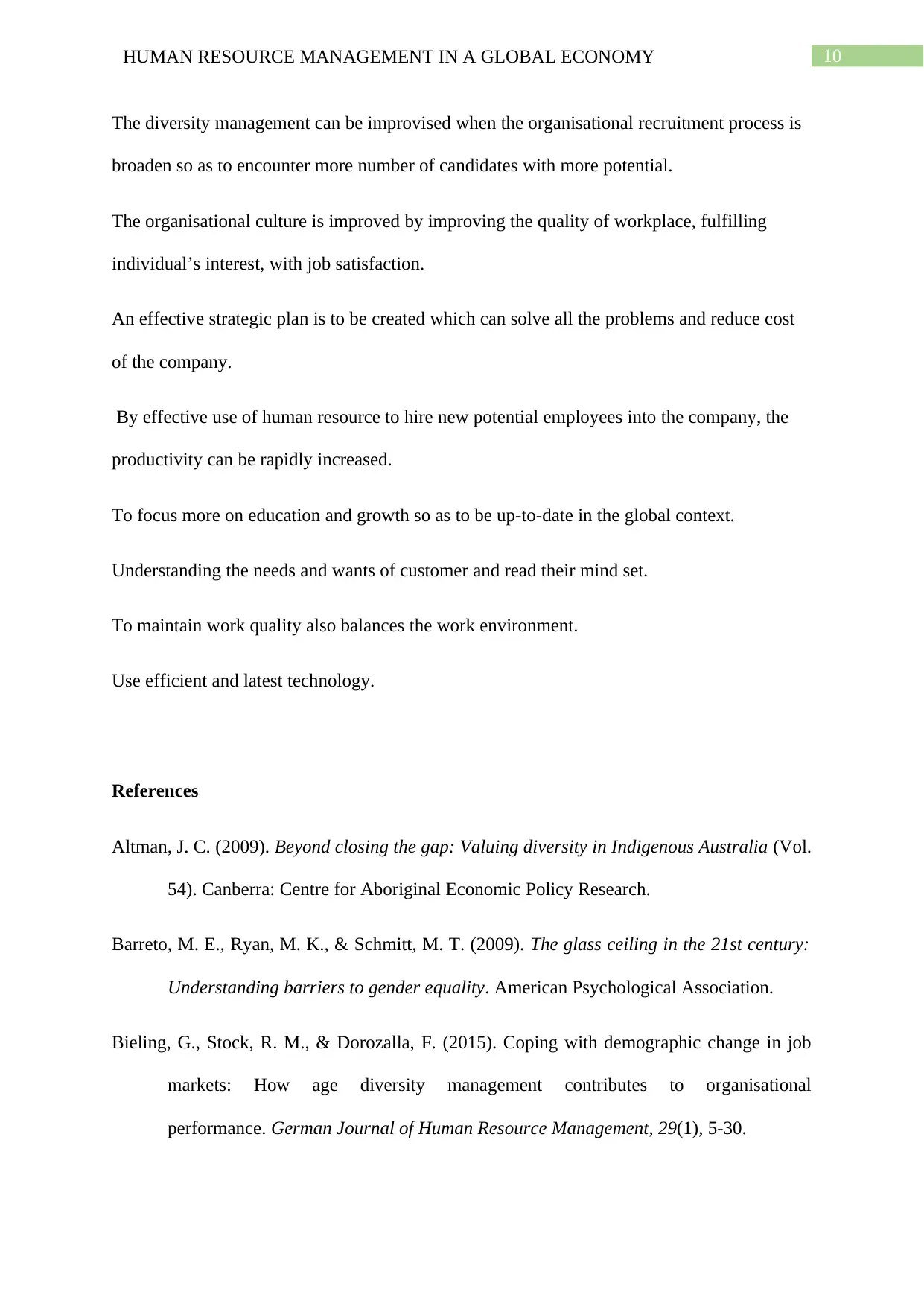
10HUMAN RESOURCE MANAGEMENT IN A GLOBAL ECONOMY
The diversity management can be improvised when the organisational recruitment process is
broaden so as to encounter more number of candidates with more potential.
The organisational culture is improved by improving the quality of workplace, fulfilling
individual’s interest, with job satisfaction.
An effective strategic plan is to be created which can solve all the problems and reduce cost
of the company.
By effective use of human resource to hire new potential employees into the company, the
productivity can be rapidly increased.
To focus more on education and growth so as to be up-to-date in the global context.
Understanding the needs and wants of customer and read their mind set.
To maintain work quality also balances the work environment.
Use efficient and latest technology.
References
Altman, J. C. (2009). Beyond closing the gap: Valuing diversity in Indigenous Australia (Vol.
54). Canberra: Centre for Aboriginal Economic Policy Research.
Barreto, M. E., Ryan, M. K., & Schmitt, M. T. (2009). The glass ceiling in the 21st century:
Understanding barriers to gender equality. American Psychological Association.
Bieling, G., Stock, R. M., & Dorozalla, F. (2015). Coping with demographic change in job
markets: How age diversity management contributes to organisational
performance. German Journal of Human Resource Management, 29(1), 5-30.
The diversity management can be improvised when the organisational recruitment process is
broaden so as to encounter more number of candidates with more potential.
The organisational culture is improved by improving the quality of workplace, fulfilling
individual’s interest, with job satisfaction.
An effective strategic plan is to be created which can solve all the problems and reduce cost
of the company.
By effective use of human resource to hire new potential employees into the company, the
productivity can be rapidly increased.
To focus more on education and growth so as to be up-to-date in the global context.
Understanding the needs and wants of customer and read their mind set.
To maintain work quality also balances the work environment.
Use efficient and latest technology.
References
Altman, J. C. (2009). Beyond closing the gap: Valuing diversity in Indigenous Australia (Vol.
54). Canberra: Centre for Aboriginal Economic Policy Research.
Barreto, M. E., Ryan, M. K., & Schmitt, M. T. (2009). The glass ceiling in the 21st century:
Understanding barriers to gender equality. American Psychological Association.
Bieling, G., Stock, R. M., & Dorozalla, F. (2015). Coping with demographic change in job
markets: How age diversity management contributes to organisational
performance. German Journal of Human Resource Management, 29(1), 5-30.
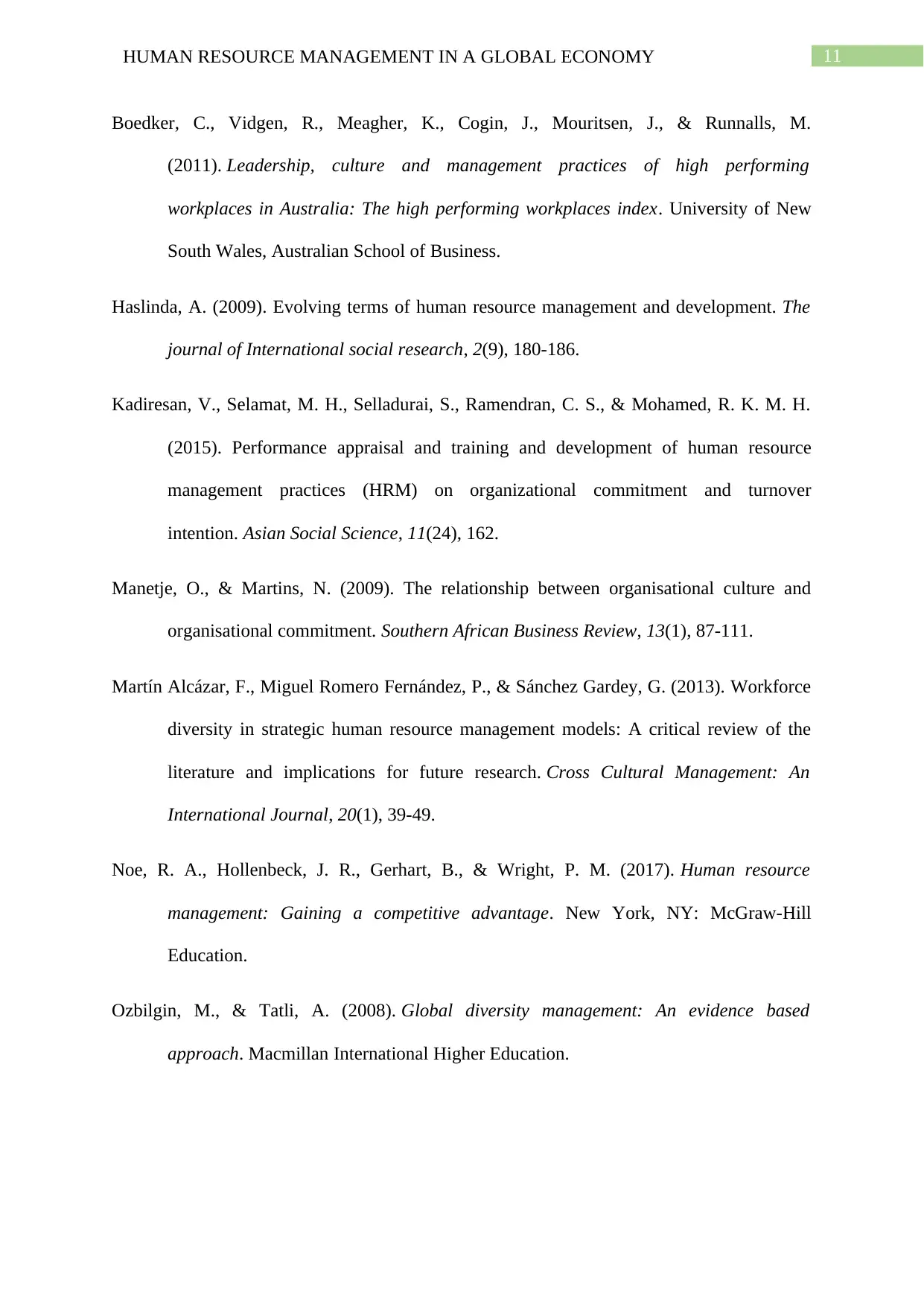
11HUMAN RESOURCE MANAGEMENT IN A GLOBAL ECONOMY
Boedker, C., Vidgen, R., Meagher, K., Cogin, J., Mouritsen, J., & Runnalls, M.
(2011). Leadership, culture and management practices of high performing
workplaces in Australia: The high performing workplaces index. University of New
South Wales, Australian School of Business.
Haslinda, A. (2009). Evolving terms of human resource management and development. The
journal of International social research, 2(9), 180-186.
Kadiresan, V., Selamat, M. H., Selladurai, S., Ramendran, C. S., & Mohamed, R. K. M. H.
(2015). Performance appraisal and training and development of human resource
management practices (HRM) on organizational commitment and turnover
intention. Asian Social Science, 11(24), 162.
Manetje, O., & Martins, N. (2009). The relationship between organisational culture and
organisational commitment. Southern African Business Review, 13(1), 87-111.
Martín Alcázar, F., Miguel Romero Fernández, P., & Sánchez Gardey, G. (2013). Workforce
diversity in strategic human resource management models: A critical review of the
literature and implications for future research. Cross Cultural Management: An
International Journal, 20(1), 39-49.
Noe, R. A., Hollenbeck, J. R., Gerhart, B., & Wright, P. M. (2017). Human resource
management: Gaining a competitive advantage. New York, NY: McGraw-Hill
Education.
Ozbilgin, M., & Tatli, A. (2008). Global diversity management: An evidence based
approach. Macmillan International Higher Education.
Boedker, C., Vidgen, R., Meagher, K., Cogin, J., Mouritsen, J., & Runnalls, M.
(2011). Leadership, culture and management practices of high performing
workplaces in Australia: The high performing workplaces index. University of New
South Wales, Australian School of Business.
Haslinda, A. (2009). Evolving terms of human resource management and development. The
journal of International social research, 2(9), 180-186.
Kadiresan, V., Selamat, M. H., Selladurai, S., Ramendran, C. S., & Mohamed, R. K. M. H.
(2015). Performance appraisal and training and development of human resource
management practices (HRM) on organizational commitment and turnover
intention. Asian Social Science, 11(24), 162.
Manetje, O., & Martins, N. (2009). The relationship between organisational culture and
organisational commitment. Southern African Business Review, 13(1), 87-111.
Martín Alcázar, F., Miguel Romero Fernández, P., & Sánchez Gardey, G. (2013). Workforce
diversity in strategic human resource management models: A critical review of the
literature and implications for future research. Cross Cultural Management: An
International Journal, 20(1), 39-49.
Noe, R. A., Hollenbeck, J. R., Gerhart, B., & Wright, P. M. (2017). Human resource
management: Gaining a competitive advantage. New York, NY: McGraw-Hill
Education.
Ozbilgin, M., & Tatli, A. (2008). Global diversity management: An evidence based
approach. Macmillan International Higher Education.
⊘ This is a preview!⊘
Do you want full access?
Subscribe today to unlock all pages.

Trusted by 1+ million students worldwide
1 out of 13
Related Documents
Your All-in-One AI-Powered Toolkit for Academic Success.
+13062052269
info@desklib.com
Available 24*7 on WhatsApp / Email
![[object Object]](/_next/static/media/star-bottom.7253800d.svg)
Unlock your academic potential
Copyright © 2020–2025 A2Z Services. All Rights Reserved. Developed and managed by ZUCOL.




